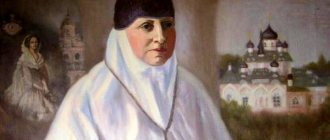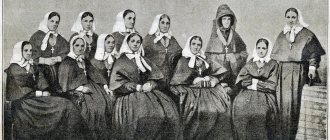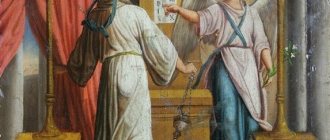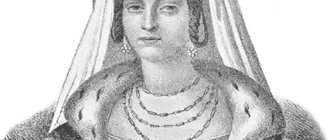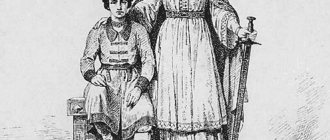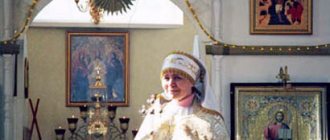Venerable Martyr Grand Duchess Elisoveta and Nun Varvara
The future Russian saint was born in 1864 in Germany, in the family of the Grand Duke of Hesse-Darmstadt, Ludwig IV. Her mother was the daughter of the Queen of England, Princess Alice. Therefore, all seven children of this German ruling couple were brought up in the traditions of old England. That is, despite their noble origins, the children themselves cleaned their rooms, lit the fireplaces, slept on hard beds and took cold baths in the morning. Since childhood, Elisaveta loved nature, she had a gift for painting, and she painted with passion. She loved classical music. Everyone who knew her in childhood noted her early religiosity and love for her neighbors. Since her believing parents spent most of their money on hospitals and shelters for the poor, Elizabeth, as a little girl, was imbued with compassion for unfortunate people.
At the age of 20, Princess Elizabeth was chosen as the wife of Grand Duke Sergei Alexandrovich, the son of the Russian Tsar Alexander II. She did not want to get married, having taken a vow of virginity in her youth and wanting to devote her life to her family, which in 1878 lost her mother, who died of diphtheria. But her acquaintance with the Grand Duke and heartfelt conversations with him revealed to her that he, too, had taken a vow of celibacy to God. By mutual agreement, they decided to enter into a spiritual marriage and live with each other like brother and sister.
Their wedding took place in St. Petersburg, first according to the Orthodox rite, then according to the Protestant rite (for a princess marrying the Grand Duke, it was not necessary to convert to Orthodoxy; this was a strict requirement of Russian laws only for the chosen one of the heir to the throne). Sergei Alexandrovich was a deeply religious person, he strictly observed all church traditions, often went to services and visited monasteries. The Grand Duchess followed her husband everywhere and stood through all the long church services with him. Gradually, Orthodoxy conquered her with its inner beauty and depth of inner content. In Orthodox churches she experienced an amazing feeling of the presence of grace.
With her characteristic moral sensitivity, the young princess began to study the national traits of the Russian people and their faith. Soon she was already writing to her family in Germany: “Even in Slavic I understand almost everything, although I never learned this language.” After visiting the Holy Land, where she and her husband attended the consecration of the temple in honor of St. Mary Magdalene in Gethsemane, Grand Duchess Elizabeth firmly decided to convert to Orthodoxy. She wrote to her father, who was against his daughter’s change of faith: “I am converting to Orthodoxy out of pure conviction; I feel that this is the highest religion and that I will do it with faith and with the deep conviction that there is God’s blessing for this.”
On Saturday, Palm Sunday, 1891, Grand Duchess Elizabeth was received into the fold of the Orthodox Church. After the sacrament of anointing was performed on her, Emperor Alexander III blessed his daughter-in-law with the icon of the Savior Not Made by Hands. Now the Grand Duchess could rightfully repeat the words of the Savior’s great-grandmother, righteous Ruth: “Your people have become my people, your God has become my God.”
In the same year, the Tsar appointed Grand Duke Sergei Alexandrovich Governor-General of Moscow. The wife of the chief of the second capital of the empire, of necessity, had to participate in social life - attend ceremonial receptions, attend concerts and balls. But St. Elizabeth was already burdened by the vanity of these duties. But she, willingly, devoted all her free time to charitable activities, trying, if possible, to improve the lot of poor people.
In 1905, Grand Duke Sergei Alexandrovich died at the hands of the terrorist Kalyaev. The greatness of spirit with which St. Elizabeth suffered a terrible grief that amazed everyone. With her own hands, she collected the parts of her husband’s body scattered by the bomb onto a stretcher. And after the first memorial service, she immediately sent a telegram to the royal couple, asking them not to come to the funeral, since terrorists could take advantage of this opportunity to assassinate the Tsar. Then she visited the Grand Duke’s mortally wounded coachman in the hospital and went to prison to see Kalyaev, who was detained at the crime scene, hoping to soften his heart and encourage him to repent of the crime committed. And after he refused to repent, she asked Emperor Nicholas II to pardon the murderer, but her request was rejected.
The tragedy she experienced produced a final change in the soul of the Grand Duchess. She stopped going out into the world and began to lead a reclusive life, deciding to devote herself to serving God and her neighbors. Soon she bought an estate with four houses and a vast garden in Moscow, on Bolshaya Ordynka. Here she decided to create a monastery in honor of Saints Martha and Mary. This was a completely new type of organized church charity for Russia, which was based on the deep thought that no person can give to another more than he himself has. Therefore, only in God can we love our neighbors to the fullness of Christian measure. Humanity or natural love quickly radiates, giving way to coldness and disappointment. But the one who lives in Christ is able to rise to the heights of complete self-denial. The Grand Duchess wanted to raise special sisters for the spiritual consolation of the seriously ill and terminally ill, standing on the edge of the grave.
The Marfo-Mariinskaya Convent began its activities in February 1909. If at first there were only six sisters, then within one year their number increased to 30, and by 1914 it reached one hundred. The sisters of the monastery were called to combine the high lot of the gospel Mary, who listens to the words of eternal life, with the hardworking feat of Martha, serving the Lord with selfless help to her neighbors. The best specialists in Moscow worked at the monastery hospital, and treatment there was free. A Sunday school was opened for factory workers, and a free canteen operated for the poor. A shelter for orphan girls and an artel of messenger boys with a comfortable dormitory for them were created. Special apartments were arranged for female students. The variety of activities of the Grand Duchess was great; she received up to 12 thousand requests for help alone per year.
The abbess of the monastery herself led the life of an ascetic: she slept on a wooden bed without a mattress for no more than three hours a day, and secretly wore a hair shirt and chains. At midnight she got up for prayer, then went around all the hospital wards and sat until dawn near the seriously ill. She also assisted in complex operations. Patients believed that healing powers emanated from her. Thanks to her help and prayers, even those whom doctors refused were healed. All believers in Russia began to call Elisaveta Feodorovna “Mother.”
Respect for the activities of the Martha and Mary Convent and its abbess was so great that the sisters were not touched even in the first months after the revolution. But in April 1918 she was arrested and taken out of Moscow. On this day of Bright Week, St. Patriarch Tikhon served a prayer service to the Iveron Icon of the Mother of God at the monastery, and then until four o’clock in the afternoon he talked with the abbess, who was experiencing spiritual anguish, anticipating something terrible. Half an hour after the patriarch's departure, she was arrested.
After a short stay in Perm, where St. Elizabeth and her companions were placed in a convent, the prisoners were transferred to the city of Alapaevsk. The last months of his life, St. the princess was imprisoned in a school on the outskirts of this Ural town together with Grand Duke Sergius Mikhailovich, his secretary F.M. Remez, three brothers - John, Konstantin and Igor (sons of Grand Duke Konstantin Konstantinovich) and Prince Paley (son of Grand Duke Pavel Alexandrovich ).
Late at night on July 5 (18), on the day of the discovery of the relics of St. Sergius of Radonezh, all these prisoners were taken out of the city and thrown alive into the shaft of an old mine. Then the security officers began throwing grenades into the mine. One of the peasants, who was an accidental witness to this murder, said that from the mine the sounds of the Cherubim were heard, which the sufferers sang before their death.
When Alapaevsk was temporarily occupied by the whites, the bodies of the martyrs were taken out of the mine. It turned out that St. Elizabeth fell not to the bottom of the shaft, but to a ledge located at a depth of about 15 meters. Next to her they found Prince John with a bandaged head - the martyr Elizabeth, herself wounded, with severe fractures, dying, tried to alleviate the suffering of her neighbor. The fingers of her right hand were crossed in the sign of the cross. On her chest they found an icon of the Savior Not Made by Hands, given to her by Emperor Alexander III on the day of her transition to Orthodoxy.
The bodies of the martyrs were washed, dressed in white clothes and placed in wooden coffins. With the retreating army of Kolchak, the remains of St. The princesses and members of the royal house were transported first to Irkutsk and then to Beijing. From here, already in 1920, through the efforts of the English relatives of the Grand Duchess, her coffin, along with the coffin of her sister Varvara, was taken to Palestine, where both coffins were placed in a tomb under the lower arches of the Russian Church of St. Mary Magdalene. There she rests to this day.
The venerable martyr Grand Duchess Elizabeth and nun Varvara were canonized as new martyrs in 1992.
Reprinted from the book: V.I. Danchuk. Lives of the Saints. Nikolo-Pogost, 2009.
| Venerable Martyr Grand Duchess Elizabeth and Nun Varvara |
Grand Duchess Elisaveta Feodorovna was born on October 20, 1864. She was the daughter of the Grand Duke of Hesse-Darmstadt Ludwig IV and Princess Alice, daughter of Queen Victoria of England. With the loss of her mother, 14-year-old Elisaveta's childhood ended.
According to the memoirs of contemporaries, Elizabeth’s beautiful appearance was consistent with her spiritual qualities. Its main distinguishing properties were religiosity and love for others.
It is believed that even in her early youth, Princess Elizabeth gave her heart to Grand Duke Sergei Alexandrovich, the son of Emperor Alexander II. On June 3, 1884, in St. Petersburg, in the Great Church of the Winter Palace, the wedding of Grand Duke Sergei Alexandrovich and Grand Duchess Elisaveta Feodorovna took place according to the Orthodox rite, and then in one of the living rooms of the palace there was a wedding according to the Protestant rite (when getting married, Elisaveta Fedorovna remained a Protestant).
In Ilyinsky, the estate of the Grand Duke near Moscow on the Moscow River, Elisaveta Feodorovna led a simple village life and helped the surrounding peasants a lot. For them, the couple built a hospital, in which the baptism of newborns was often performed, and Sergei Alexandrovich and Elisaveta Fedorovna were the recipients.
Gradually, Elisaveta Feodorovna became more and more internally closer to Russia and Orthodoxy.
In October 1888, Grand Duke Sergei Alexandrovich and Grand Duchess Elisaveta Feodorovna, on behalf of Emperor Alexander III, visited Palestine to consecrate the magnificent Church of St. Mary Magdalene, built in Gethsemane.
Returning from the Holy Land, full of indelible impressions, Elisaveta Fedorovna decided to convert to Orthodoxy. However, her relatives from Darmstadt did not understand or support her. Only her grandmother, Queen Victoria of England, encouraged her. In a response letter, a grateful Elizabeth wrote to her: “...You cannot imagine how strongly and deeply I was touched by everything that you wrote... The Lord gave me courage... I do this, belonging with all my soul to this Church here, and I feel , that she lied to everyone and my old religion, continuing to remain a Protestant. This is a big matter of conscience, where only a person related to this can truly understand the full depth of this step.”
On Saturday, Palm Sunday, April 13, 1891, Grand Duchess Elizabeth's conversion to Orthodoxy took place. Now she could rightfully say to her husband, and to every Orthodox Russian person, in the words of the Moabite Ruth: “Your people will be my people, and your God will be my God” (Ruth. 1:16).
Converting to Orthodoxy, the Grand Duchess did not want to part with her name, but only chose a new heavenly patroness - the holy righteous Elizabeth, the mother of the Forerunner and Baptist of the Lord John, whose memory the Orthodox Church celebrates on September 5.
In 1891, Grand Duke Sergei Alexandrovich was appointed governor general of Moscow. Here, Elisaveta Feodorovna’s charitable activities unfolded in all their breadth.
Constantly visiting numerous Moscow churches, the Grand Duchess everywhere saw ragged beggars on the porches, crying out for help. She also visited hospitals for the poor, nursing homes, shelters for street children, and prisons. And everywhere she tried to do something to alleviate human suffering, she distributed food and clothing. The residents of Moscow very soon appreciated her kindness, and the Grand Duchess won their sincere love.
When Emperor Alexander III died on October 20, 1894, the future empress, Elizabeth Feodorovna’s sister Princess Alice, converted to Orthodoxy and took the name Alexander. Elisaveta Fedorovna took an active part in this.
July 1903 was marked by a great event in the life of Russia: St. Seraphim of Sarov was canonized. The entire imperial family traveled to Sarov. “So many beautiful and healthy impressions!..” wrote Elisaveta Fedorovna. - What weakness, what illnesses we saw, but also what faith. It seemed that we were living during the time of the Savior’s earthly life.”
Soon the tragic Russo-Japanese War of 1904-1905 began for Russia. Elisaveta Fedorovna, who already had extensive experience in charity work, immediately began active work to help the front. She formed several well-equipped ambulance trains and set up hospitals in Moscow to receive the wounded. She did not forget about the spiritual needs of the Russian people, she sent camp churches to the army, and supplied them with everything necessary for worship.
On February 5, 1905, in the Kremlin, terrorist Ivan Kalyaev threw a bomb at Grand Duke Sergei Alexandrovich, which tore him into pieces.
Showing amazing fortitude, the Grand Duchess visited the murderer in prison, left him the Holy Gospel and asked the emperor for his pardon.
Having experienced a terrible shock, Elisaveta Fedorovna went even deeper into prayer and devoted herself to charity with even greater zeal.
Elisaveta Fedorovna bought an estate with four houses and a vast garden in Moscow, on Bolshaya Ordynka. Here she decided to create a monastery in honor of Saints Martha and Mary. The monastery was intended to be like the house of Lazarus, where Christ the Savior often visited. The sisters of the monastery were called to unite in their feat both the high lot of Mary, who listens to the eternal verbs of life, and the ministry of Martha, since they lovingly received Christ in the person of His younger brothers. For this purpose, in addition to the temple, a hospital, pharmacy, and shelter were created in the monastery. Elisaveta Feodorovna built a beautiful garden around the buildings.
The Marfo-Mariinskaya Convent began its activities on February 10, 1909. When the monastery opened, there were only six sisters in it; within a year their number increased to thirty, and by 1914 it reached one hundred.
On April 9, 1910, in accordance with the rite developed by the Holy Synod, Bishop Tryphon (Turkestan) ordained 17 sisters of the monastery, led by Grand Duchess Elizabeth, to the rank of cross sisters of love and mercy.
They all made a solemn vow to devote themselves to serving God and their neighbors.
Being a sincere and obedient daughter of the Orthodox Church in everything, the abbess did not want to take advantage of her position as a Grand Duchess.
Leading a strict ascetic life, Elisaveta Fedorovna did not demand the same from her sisters. She made sure that they had a good table and enough time to sleep. She herself slept no more than three hours a day, on a hard bed, ate a little vegetables and milk, and strictly observed fasts. At night I prayed for a long time, then walked around the hospital wards. The abbess took upon herself all the most difficult responsibilities. She cared for hopeless patients, often spent the whole night with them, and assisted during operations. The patients said that the mere presence of the abbess gave them peace, eased their suffering and helped them undergo operations with ease. They felt the healing power emanating from her.
The monastery hospital enjoyed such a reputation in Moscow that sometimes the most seriously ill patients from other hospitals were sent here. And the abbess amazed Moscow doctors with her selfless care for the sick and amazing results. As she herself said, sharing your grief means reducing it, and sharing your joy means increasing it.
In the Martha and Mary Convent, through the diligence of the abbess, several churches were built: in the name of the holy women Martha and Mary, in the name of the Protection of the Most Holy Theotokos, and in 1914, under this temple, a church-tomb for sisters in the name of the Heavenly Powers and All Saints was built. Elisaveta Fedorovna thought that her body would rest there after her death. There she often indulged in prayer.
The abbess of the monastery also had in mind to prepare special sisters for the spiritual consolation of seriously ill patients standing on the edge of the grave. “Isn’t it scary,” she said, “that out of false humanity we try to lull such sufferers to sleep with the hope of their imaginary recovery. We would do them a better service if we prepared them in advance for the Christian transition into eternity.”
Elisaveta Fedorovna loved to travel to remote monasteries, where she could devote herself entirely to prayer, as well as church charity. Poor parishes and monasteries received especially great help from her. Reverently revering St. Seraphim of Sarov, Grand Duchess Elizabeth repeatedly went to Sarov to pray at the relics of the saint of God. She also traveled to Pskov, Kyiv, Optina Pustyn, and visited the smallest monasteries in remote places in Russia, where she communicated with many Russian monastic ascetics.
Having inherited the chairmanship of the Palestine Society from her late husband, Elisaveta Fedorovna showed special concern for Russian pilgrims heading to the Holy Land.
On the initiative of Elisaveta Fedorovna in Italy, in Bari, a large plot of land was acquired, where construction of a temple and a courtyard began.
The news of the beginning of the First World War found the abbess of the Martha and Mary Convent in the remote Seraphim-Alekseevsky monastery of the Perm diocese. When she returned to Moscow, some sisters asked her to let them go to the front. After consulting with the confessor of the monastery, she gave her consent.
When in hospitals, the abbess of the Marfo-Mariinsky Convent visited the wounded. As a Christian, she showed mercy to enemy soldiers. This, however, gave rise to slanderous fabrications and even open expressions of hatred towards her, which was very difficult for her and forced her to stop visiting the wounded prisoners. To find peace of mind, Elisaveta Fedorovna went to the Optina elders for several days.
Wild fictions about the Marfo-Mariinsky Monastery as a center of German espionage began to spread throughout Moscow. Realizing that military failures could not but affect the philistine mood, Elisaveta Fedorovna tried to find an excuse for people. “They are all very tired. The people are children,” she said meekly, “they are not to blame for the present.” He has been misled by Russia’s enemies.”
One day in the fall of 1916, an angry crowd, excited by rumors, gathered at the gates of the monastery. “Down with the German! Give up the spy!" — stones flew into the windows. When the crowd began to break into the gates of the monastery, they opened and she appeared before everyone - completely alone! - Mother Superior. She suggested inspecting all the premises, making sure that there were no spies in the monastery, and not disturbing the sick with noise.
Disastrous unrest intensified throughout the country. Worried about the royal family, Elisaveta Feodorovna said to Archbishop Anastasy (Gribanovsky) with some enlightened gentleness: “This will serve to their moral purification and bring them closer to God.”
To repeated proposals from diplomats of foreign powers to leave Russia in this troubled and dangerous time, she replied that although she foresaw the onset of terrible times, she would share the fate of the country that had received her, would not leave the sisters of the monastery and prayed to God to grant her the strength to drink the cup of suffering.
On the third day of Easter 1918 (the day of the celebration of the Iveron Icon of the Mother of God), His Holiness Patriarch Tikhon visited the Martha and Mary Convent, where he served a prayer service, and then stayed until four o’clock in the afternoon, talking with the abbess, who was experiencing spiritual anguish, anticipating something terrible.
Half an hour after the departure of His Holiness the Patriarch, a car with a commissar and Red Army soldiers drove up to the monastery, and Elisaveta Feodorovna was ordered to immediately go with them. She was arrested and taken away from Moscow.
Having learned about what had happened, His Holiness Patriarch Tikhon tried in vain to achieve the release of Elizabeth Feodorovna.
Two sisters went with the abbess - cell attendant Varvara Yakovleva and Ekaterina Yanysheva.
In Perm, the exiled abbess and her companions Varvara and Ekaterina were placed in a convent, where they were treated with sincere sympathy. A great consolation for them was the opportunity to attend services in the monastery church.
On May 20, 1918, the prisoners were brought to Alapaevsk. They were placed in a school on the outskirts of the city. At first they could go to church, work in the garden, walk in the field, but from June 21 all this was prohibited to them and their living conditions deteriorated sharply.
Around the same time, Elisaveta Feodorovna was separated from her companions. They were afraid of the torment that Elisaveta Feodorovna would have to endure. However, Varvara Yakovleva replied that she was ready to sign with her blood: she wanted to share the fate of her abbess. As she was older in age, she was returned to Alapaevsk. The nun Varvara remained faithful to her mother to the end and, together with her, voluntarily went to suffering and death, fulfilling the covenant of Christ: “Greater love has no one than this, that someone lay down his life for his friends” (John 15:13).
On July 5, when the Orthodox Church celebrates the memory of St. Sergius of Radonezh (the day of the angel of Elizabeth Feodorovna’s late husband, Grand Duke Sergei Alexandrovich), Elisaveta Feodorovna and the nun Varvara Yakovleva were woken up at night and taken along the road in the direction of the village of Sinyachikha. Together with them, several carts carried members of the imperial family: Grand Duke Sergei Mikhailovich with his secretary Fyodor Remez, the sons of Grand Duke Konstantin Konstantinovich John, Konstantin and Igor, as well as Prince Vladimir Paley. About 18 kilometers from Alapaevsk, not far from the road, there was an abandoned mine. The executioners chose one of the mine shafts, Nizhnyaya Selimskaya, to carry out their brutal plan. The mine was about sixty meters deep, its log walls were half-rotten, and there was water below.
Beating the innocent victims with rifle butts, the executioners began to throw them into the mine, dooming them to a slow, terrible death. A local peasant who happened to be near the mine saw this.
The first to be pushed into the gaping hole was Grand Duchess Elizabeth. Making the sign of the cross, she loudly prayed: “Lord, forgive them, they don’t know what they’re doing!” The rest of the martyrs, except for Grand Duke Sergei Mikhailovich, who fought with the executioners and was shot in the head, were also pushed into the mine alive.
When they threw everyone down, the executioners began throwing hand grenades into the mine. However, as subsequent excavations showed, except for Fyodor Remez, the rest of the martyrs apparently died a slow death from thirst, wounds and hunger.
The Grand Duchess Nun Elizabeth fell not to the bottom of the shaft, but to a ledge located at a depth of about 15 meters. During the excavations, next to her, they found Prince John with a bandaged head - the martyr Elizabeth, herself severely wounded, made a bandage for him in the dark from her apostle.
A peasant, a bystander, heard the Cherubic song heard from the depths of the mine. The new martyrs sang it.
When the body of the martyr was discovered, it turned out that the fingers of her right hand were folded to make the sign of the cross. The fingers of the nun Varvara and Prince John were folded in the same way.
An icon of the Savior was found on the chest of Elizabeth Feodorovna. On the reverse side of the icon was the inscription “Palm Saturday, April 13, 1891.” This is the date of the transition of Grand Duchess Elizabeth Feodorovna to Orthodoxy. She clutched the icon to herself with prayer during the terrible dying hours.
The bodies of the martyrs were washed, dressed in white clothes and placed in wooden coffins. On the evening of October 5, 1918, a funeral all-night vigil was celebrated by numerous clergy. The next day, a religious procession was made from the Holy Trinity Cathedral to the cemetery church, where a requiem mass was served. Accompanied by the singing of “Holy God...” the coffins were carried into the cathedral. There, after the funeral liturgy, the funeral of the martyrs took place.
In connection with the approach of the Red Guard armed detachments, the bodies of the martyrs were transported to Chita and installed in the Pokrovsky convent. In the monastery the coffins were opened. The body of the martyr Grand Duchess nun Elizabeth was not touched by decay. The nuns washed the bodies of the martyrs Grand Duchess Elizabeth and nun Varvara and dressed them in monastic robes. In April 1920, their bodies were taken to Beijing.
Elisaveta Fedorovna's sister and brother, having learned where the remains of the dead were located, wished that the incorrupt bodies of Grand Duchess Elisaveta and nun Varvara be transported to Jerusalem and buried near the Church of St. Mary Magdalene, at the consecration of which Elisaveta Feodorovna was present in 1888. The wish was fulfilled, and the coffins were installed in the tomb of the Church of St. Mary Magdalene.
The Grand Duchess and Martyr Elizabeth walked through the Russian land like a bright, beautiful vision. Having abandoned her brilliant position, overcoming religious and national barriers, she, a German Protestant by birth and upbringing, accepted Orthodoxy, created a Russian Orthodox monastic monastery, performed many feats of mercy and ended her earthly life with voluntary martyrdom, remaining faithful to her Christian duty to the end .
Currently, the relics of the venerable martyrs Grand Duchess Elizabeth and nun Varvara reside in the Church of St. Mary Magdalene in Jerusalem.
By the act of the Consecrated Council of Bishops of the Russian Orthodox Church in 1992, the venerable martyr Grand Duchess Elizabeth and nun Varvara were canonized as saints for church-wide veneration.
They are commemorated on the day of their martyrdom, July 5, and on the day of the Council of New Martyrs and Confessors of Russia (movable celebration on the last Sunday of January).
Reprinted from www.ispovednik.ru
Return to the list “Selected lives of saints according to Philaret of Chernigov”
Return to the main list of “Lives of Saints”
Recommend this page to a friend!
Icon with a particle of the relics of the Prmcc. Elizabeth and Barbara
July 18
Troparion of the Venerable Martyr Grand Duchess Elisaveta Feodorovna
voice 1
Having hidden your princely dignity with humility, the godly Elisaveto honored Christ with the intense service of Martha and Mary. You have purified yourself with mercy, patience and love, as if you offered a righteous sacrifice to God. We, who honor your virtuous life and suffering, earnestly ask you as a true mentor: Holy Martyr Grand Duchess Elizabeth, pray to Christ God to save and enlighten our souls.
Kontakion of the Venerable Martyr Grand Duchess Elisaveta Feodorovna
voice 2
Who tells the story of the greatness of the feat of faith? In the depths of the earth, as if in the paradise of lordship, the passion-bearer Grand Duchess Elizabeth and the angels rejoiced in psalms and songs and, enduring murder, cried out for the godless tormentors: Lord, forgive them this sin, for they do not know what they are doing. Through your prayers, O Christ God, have mercy and save our souls.
The Venerable Martyr Grand Duchess Elizabeth was born on October 20, 1864 into the Protestant family of the Grand Duke of Hesse-Darmstadt Ludwig IV and Princess Alice, daughter of Queen Victoria of England. In 1884, she married Grand Duke Sergei Alexandrovich, brother of Emperor Alexander III of Russia.
Seeing the deep faith of her husband, the Grand Duchess with all her heart sought the answer to the question - which religion is true? She prayed fervently and asked the Lord to reveal His will to her. On April 13, 1891, on Lazarus Saturday, the rite of acceptance into the Orthodox Church was performed over Elisaveta Feodorovna. In the same year, Grand Duke Sergei Alexandrovich was appointed Governor-General of Moscow.
Visiting churches, hospitals, orphanages, nursing homes and prisons, the Grand Duchess saw a lot of suffering. And everywhere she tried to do something to alleviate them.
After the start of the Russian-Japanese War in 1904, Elisaveta Feodorovna helped the front and Russian soldiers in many ways. She worked until she was completely exhausted.
On February 5, 1905, a terrible event occurred that changed the whole life of Elisaveta Feodorovna. Grand Duke Sergei Alexandrovich died from a bomb explosion by a revolutionary terrorist. Elisaveta Feodorovna rushed to the scene of the explosion and saw a picture that surpassed human imagination in its horror. Silently, without screaming or tears, kneeling in the snow, she began to collect and place on a stretcher the body parts of her beloved husband, who had been alive just a few minutes ago.
In the hour of difficult trials, Elisaveta Feodorovna asked for help and consolation from God. The next day she received Holy Communion in the church of the Chudov Monastery, where her husband’s coffin stood. On the third day after the death of her husband, Elisaveta Feodorovna went to prison to see the killer. She didn't hate him. The Grand Duchess wanted him to repent of his terrible crime and pray to the Lord for forgiveness. She even submitted a petition to the Emperor to pardon the killer.
Elisaveta Feodorovna decided to devote her life to the Lord through serving people and create a monastery of work, mercy and prayer in Moscow. She bought a plot of land with four houses and a large garden on Bolshaya Ordynka Street. In the monastery, which was named Marfo-Mariinskaya in honor of the holy sisters Martha and Mary, two churches were created - Marfo-Mariinsky and Pokrovsky, a hospital, which was later considered the best in Moscow, and a pharmacy in which medicines were dispensed to the poor for free, an orphanage and a school. . Outside the walls of the monastery, a house-hospital was set up for women suffering from tuberculosis.
On February 10, 1909, the monastery began its activities. On April 9, 1910, during the all-night vigil, Bishop Trifon of Dmitrov (Turkestan; + 1934), according to the rite developed by the Holy Synod, consecrated the nuns to the title of sisters of the cross of love and mercy. The sisters took a vow, following the example of the nuns, to spend a virgin life in work and prayer. The next day, during the Divine Liturgy, Saint Vladimir, Metropolitan of Moscow and Kolomna, placed eight-pointed cypress crosses on the sisters, and elevated Elisaveta Feodorovna to the rank of abbess of the monastery. The Grand Duchess said that day: “I am leaving the brilliant world... but together with you all I am ascending into a greater world - the world of the poor and suffering.”
At the Martha and Mary Convent, Grand Duchess Elisaveta Feodorovna led an ascetic life: she slept on a wooden bed without a mattress, often for no more than three hours; she ate food very moderately and strictly observed fasts; at midnight she got up for prayer, and then went around all the hospital wards, often remaining at the bedside of a seriously ill patient until dawn. She told the sisters of the monastery: “Isn’t it scary that out of false humanity we are trying to lull such sufferers to sleep with the hope of their imaginary recovery. We would do them a better service if we prepared them in advance for the Christian transition into eternity.” Without the blessing of the monastery’s confessor, Archpriest Mitrofan Serebryansky, and without the advice of the elders of the Optina Vvedenskaya Hermitage and other monasteries, she did nothing. For complete obedience to the elder, she received inner consolation from God and gained peace in her soul.
Since the beginning of the First World War, the Grand Duchess organized assistance to the front. Under her leadership, ambulance trains were formed, warehouses for medicines and equipment were set up, and camp churches were sent to the front.
The abdication of Emperor Nicholas II from the throne was a big blow for Elizabeth Feodorovna. Her soul was shocked, she could not speak without tears. Elisaveta Feodorovna saw into what abyss Russia was flying, and she wept bitterly for the Russian people, for her dear royal family.
Her letters from that time contain the following words: “I felt such deep pity for Russia and its children, who currently do not know what they are doing. Isn't it a sick child whom we love a hundred times more during his illness than when he is cheerful and healthy? I would like to bear his suffering, to help him. Holy Russia cannot perish. But Great Russia, alas, no longer exists. We... must direct our thoughts to the Kingdom of Heaven... and say with humility: “Thy will be done.”
Grand Duchess Elisabeth Feodorovna was arrested on the third day of Easter 1918, Bright Tuesday. On that day, Saint Tikhon served a prayer service at the monastery.
The monastery sisters Varvara Yakovleva and Ekaterina Yanysheva were allowed to go with her. They were brought to the Siberian city of Alapaevsk on May 20, 1918. Grand Duke Sergei Mikhailovich and his secretary Feodor Mikhailovich Remez, Grand Dukes John, Konstantin and Igor Konstantinovich and Prince Vladimir Paley were also brought here. Elisaveta Feodorovna's companions were sent to Yekaterinburg and released there. But sister Varvara ensured that she was left with the Grand Duchess.
On July 5 (18), 1918, the prisoners were taken at night in the direction of the village of Sinyachikha. Outside the city, in an abandoned mine, a bloody crime took place. With loud curses, beating the martyrs with rifle butts, the executioners began to throw them into the mine. The first to be pushed was Grand Duchess Elizabeth. She crossed herself and prayed loudly: “Lord, forgive them, they don’t know what they’re doing!”
Elisaveta Feodorovna and Prince John fell not to the bottom of the mine, but to a ledge located at a depth of 15 meters. Severely wounded, she tore off part of the cloth from her apostle and bandaged Prince John to ease his suffering. A peasant who happened to be near the mine heard the Cherubic Song sounding in the depths of the mine - the martyrs were singing.
A few months later, the army of Admiral Alexander Vasilyevich Kolchak occupied Yekaterinburg, and the bodies of the martyrs were removed from the mine. The venerable martyrs Elizabeth and Barbara and the Grand Duke John had their fingers folded for the sign of the cross.
During the retreat of the White Army, the coffins with the relics of the holy martyrs were delivered to Jerusalem in 1920. Currently, their relics rest in the Church of Equal-to-the-Apostles Mary Magdalene at the foot of the Mount of Olives.
The venerable martyr nun Varvara was a sister of the cross and one of the first nuns of the Marfo-Mariinsky monastery in Moscow. Being a cell attendant and the sister closest to Grand Duchess Elisaveta Feodorovna, she did not boast or be proud of it, but was kind, affectionate and courteous to everyone, and everyone loved her. In Yekaterinburg, sister Varvara was released, but both she and another sister, Ekaterina Yanysheva, asked to be returned to Alapaevsk. In response to the intimidation, Varvara said that she was ready to share the fate of her mother abbess. As she was older in age, she was returned to Alapaevsk. Varvara was killed along with other Alapaevsk martyrs.
The memory of the venerable martyrs Grand Duchess Elizabeth and nun Varvara is celebrated on July 5 (18) and on the day of the Council of New Martyrs and Confessors of Russia.
How Saints Elizabeth and Barbara help
Through the icons of His saints, the Lord sends us what we ask for, useful for our souls. The saints, just like us, who have walked the earthly path, know our needs. They experienced the same experiences, overcame similar earthly difficulties. When we ask a saint for intercession, we ask that he convey our prayer to God and that the saint’s prayers will be heard faster than our sincere appeal to them. The icon of the Venerable Martyr Elizabeth and nun Barbara helps to establish a prayerful connection with the holy intercessors. Having before us a visual image of the holy martyrs, our prayer is not dissipated into empty ideas and dreams. And according to the faith of the one who asks, the Lord, through His saints, gives us what we ask.
Before the image of the Venerable Martyr Elizabeth and nun Varvara they pray:
— About strengthening faith — About help in organizing earthly affairs — About healing of bodily and spiritual infirmities.
Truly wonderful is God in His saints! Dear believers, brothers and sisters! Do not doubt the help of the Venerable Martyr Elizabeth and the nun Varvara! Open your heart to them in sincere prayer and they will hear us, heal spiritual and physical infirmities, and help in the successful arrangement of earthly affairs.
Do not forget that in order for a miracle to happen, we ourselves must take care: regularly, with attention, read the prayer, do deeds of faith and love. And don’t forget to give thanks: to thank all the people sent to us by the grace of God to solve our life’s troubles, who shared our joy and sorrow. To thank the Saint, whose prayerful support our heart yearned for, because how many people pray to him for help, but he heard and helped us too. And most importantly, thank the Lord for His boundless love for mankind. He gave the world His saints and every second helps us, people who hope for His great mercies.
Everything in the world happens according to the wise providence of God. Difficulties and sorrows, success and joys. Through earthly trials the Lord strengthens us. By helping each other, praying to the heavenly saints, we are more firmly united in the One Church of Christ. And we believe that the Venerable Martyr Elizabeth and the nun Varvara will hear all our prayers and show us the boundless mercy of our Lord Jesus Christ. Thank God for everything!
